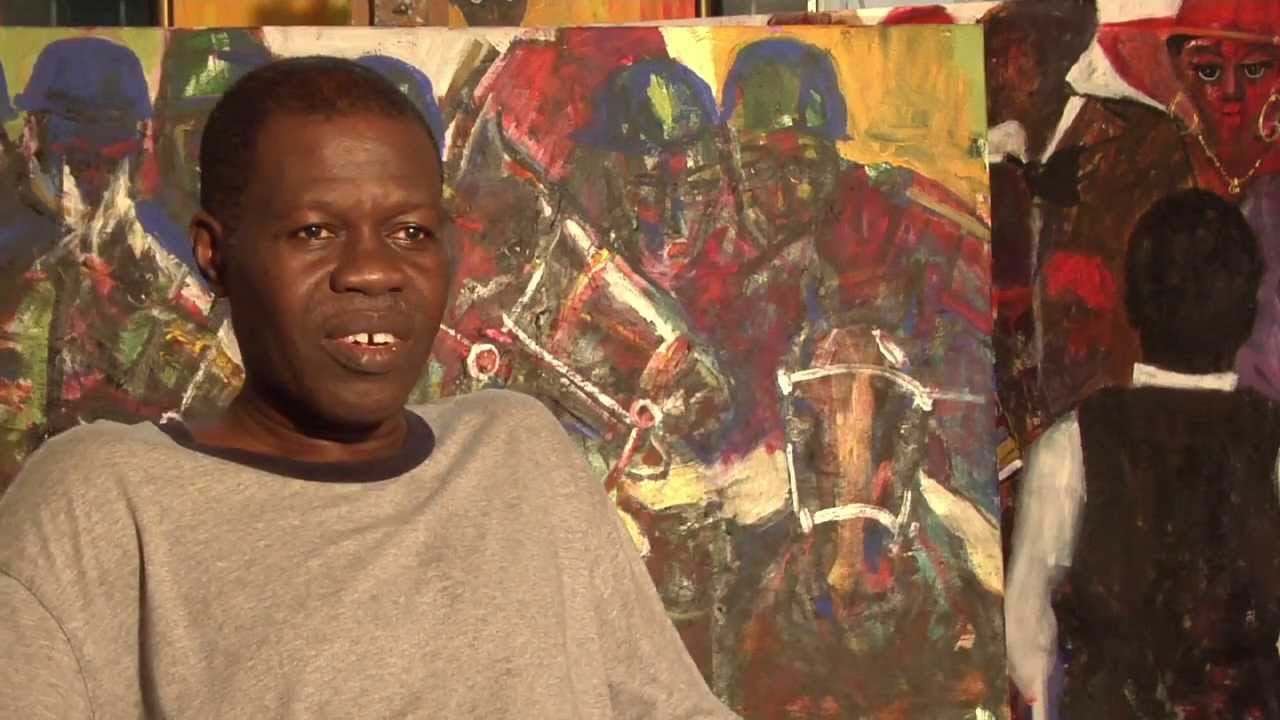In school you learn that certain colours do not agree when they come together. But Larry Otoo has come to realize very soon after leaving school that this is “a total lie”. Certain colours rather attract each other and instead of repelling each other they harmonize. Listening to Larry Otoo speaking with Safia Dickersbach in his artist studio, it very quickly becomes clear that coloration and the careful, but sometimes bold combination of colours have a special relevance for Larry Otoo’s artistic oeuvre.
Larry Otoo was born in 1956. Already his art teacher at secondary school foretold him that his talent would sometime allow him to pursue art up to a very high level. Only his father, an economist, was not enthusiastic about such plans and wanted him to study economics. But Larry Otoo bypassed his father and applied to study art at the Kwame Nkrumah University of Science and Technology in Kumasi. There at the College of Art he was graduated in 1981 as a painter and also with a master’s degree in African Art and Comparative Literature. During his studies he learned about the various ways in which the different ethnic groups in Africa were practising art and he understood better the cultural differences and the cultural diversity between nations and ethnic communities in West Africa and beyond. This understanding helped him later in his work as an artist to implement cultural and social influences from very diverse sources and to create a personal artistic style out of these inspirations.
When Larry Otoo says that art is his life, he means it also in a figurative sense. During daily life he records the impressions he gets while following regular activities in the city, on the streets, in the market or at the beach, and later in his artistic studio he recollects these images, impressions and perceptions and lets them drive his creative abilities. It is the thoughts that come to his mind which Larry Otoo translates into colours, shapes and rhythm on the canvas. Art is not only his life, but it is also his way of talking and communicating, it is his synthesis and summary of human interaction.
The daily impressions, the way the people talk and move and work in public settings, the very details of life also provide the subject matters of his paintings. Sometimes described as a “contemporary traditionalist” Larry Otoo paints to recreate his perception of what was happening at a certain moment in time, capturing the “living installation”, as he calls it, that he witnessed and recorded in his surroundings.
Larry Otoo does not adhere to one specific artistic style in his painting. He does not deliberately paint in an abstract way. But sometimes during the process of painting an artwork reaches a certain stage which is so appealing that the work simply seems right even if the subject matter of the painting might not yet have become clear to the eye of an occasional viewer. At this point it becomes irrelevant whether the form of a painted person on the canvas really depicts a human body, because Larry Otoo simply feels that the painting should be left as it is, and this final result of a painting might then look to someone else seeing it for the first time like an abstract painting.
Larry Otoo’s subject matters have changed in the course of time. Whereas he started with depicting traditional market scenes 15 years ago, he currently prefers contemporary themes like jazz music, polo competitions, aspects of the life of the bourgeoisie, people playing cards or chess. But still in the way he alternates in his stylistic tools between realism, expressionism and abstraction, a highly sophisticated ability to make use of the various possibilities of artistic expression is revealed. And in the depiction of a subject matter which at first glance does not have anything to do with the African roots of its artistic creator, a certain African handwriting cannot be overlooked, a slight reminiscence of the mysterious attraction of this continent is still discernible.
Read about the project on “This Is Africa”: http://bit.ly/16ejiHb
Editing: David Picard
Camera: Enes Hakan Tokyay
Music (for the questions): Ayo Nelson-Homiah — “Express”
Photos of the paintings: Ben Bond and Robin Riskin
Music (for the credits): Sarkodie (feat. El) — “You Go Kill Me”
A film by Safia Dickersbach
FACEBOOK: https://www.facebook.com/pages/SHOWCASE/203245376412487
.
source

